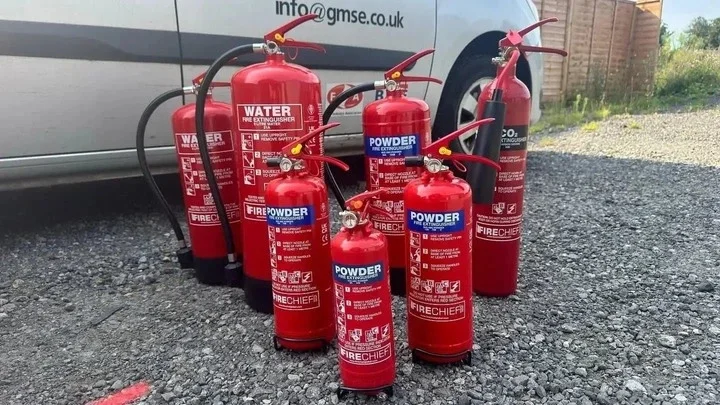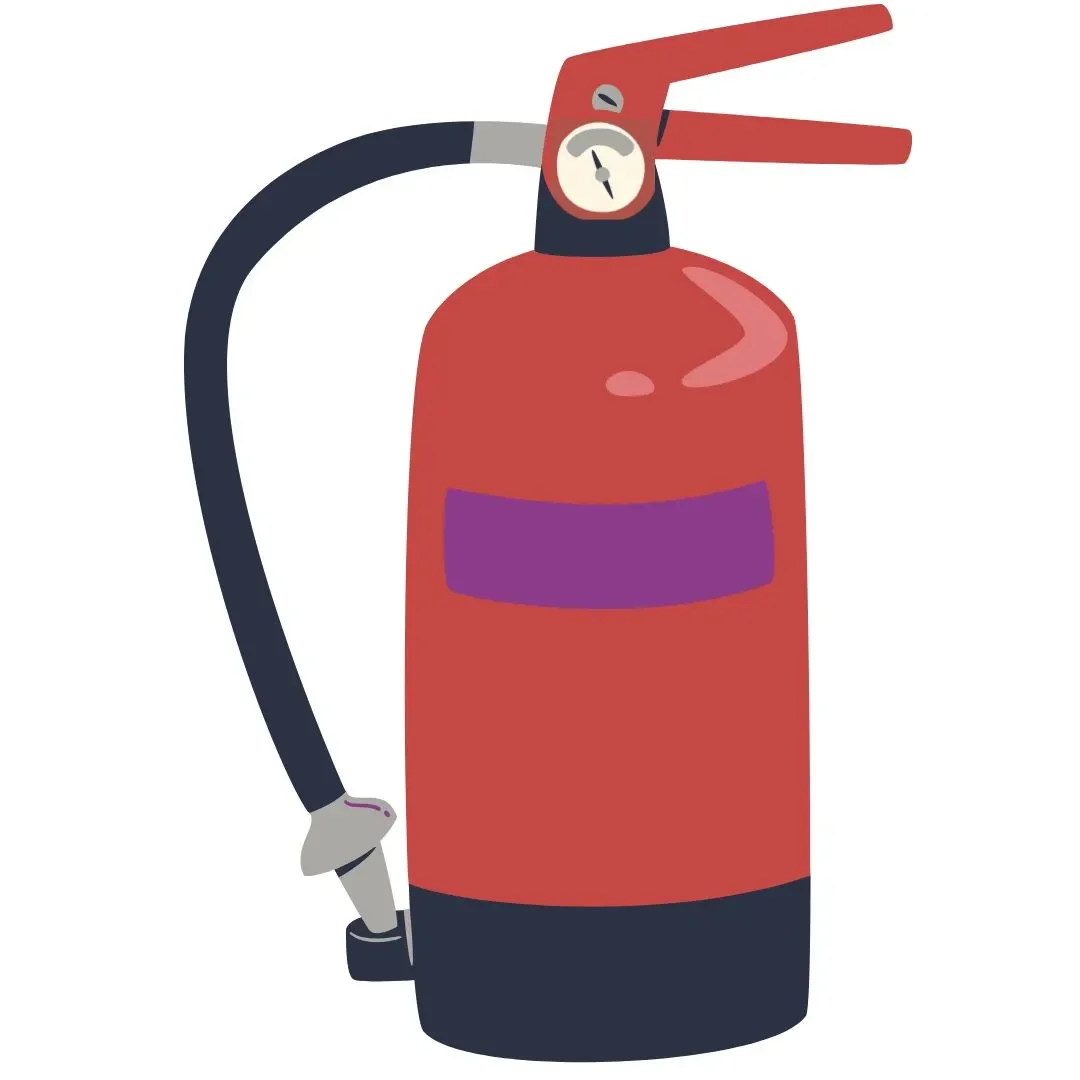Types of Fire Extinguishers: A Guide for UK Businesses
When a fire breaks out, every second matters, and grabbing the wrong extinguisher could make things worse. That’s why understanding the different types of fire extinguishers isn’t just handy - it’s a legal and safety essential.
In this guide, we’ll break down the variety of fire extinguishers used in the UK, explain their colour codes, and help you confidently select the right one for your premises. Whether you manage an office, warehouse, shop, or HMO, this guide will arm you with the knowledge to stay compliant and safe.
Already know you need a professional to help with your extinguisher setup or servicing?
Explore fire extinguisher services from GMSE Fire & Security
Table of Contents
Why fire extinguishers are not one-size-fits-all
Each type of fire extinguisher is designed to tackle specific fire classes. Use the wrong one, and you could endanger lives, worsen the fire, or even break UK regulations.
For example, a water fire extinguisher used on an electrical fire? That’s not just ineffective, it’s dangerous.
Fire extinguishers in the UK are colour-coded to help you instantly identify the correct one, and as a business owner or landlord, you are legally responsible for ensuring the correct types are installed and regularly maintained.
The 6 different types of fire extinguishers in the UK
Here’s a breakdown of the most commonly used extinguishers and what each one is designed to tackle:
1. Water Fire Extinguishers (Red Label)
Best for: Class A fires - solid combustibles like wood, paper, and textiles
Avoid using on: Electrical fires, flammable liquids, or kitchen fires
These are among the most common extinguishers and work by cooling the fire’s fuel source. They are simple, cost-effective, and easy to refill, but must never be used where electricity or oil is involved.
2. Foam Fire Extinguishers (Cream Label)
Best for: Class A and Class B fires - flammable solids and liquids like petrol or paint
Avoid using on: Electrical fires
Foam extinguishers are great all-rounders, particularly in environments like garages, warehouses, and offices where flammable liquids may be present. They form a cooling layer and prevent re-ignition.
3. CO2 Fire Extinguishers (Black Label)
Best for: Electrical fires and Class B fires
Avoid using on: Class A fires (e.g. paper, wood)
CO2 extinguishers displace oxygen, suffocating the fire without leaving residue. They're ideal for server rooms, offices, or retail environments where electrical equipment is everywhere.
4. Dry Powder Fire Extinguishers (Blue Label)
Best for: Class A, B, and C fires - flammable gases like propane
Avoid using indoors due to inhalation risks
Also known as ABC extinguishers, these are powerful and versatile. However, they’re best suited for external use or environments with specific risks (like fuel depots or workshops) because of the mess and respiratory hazard they pose indoors.
5. Wet Chemical Fire Extinguishers (Yellow Label)
Best for: Class F fires - cooking oils and fats
Avoid using on: Flammable liquids or electrical fires
These are essential for commercial kitchens, as they’re the only type suitable for deep-fat fryer fires. The extinguisher emits a cooling mist and forms a soapy barrier to stop re-ignition.
6. Specialist Fire Extinguishers (e.g. Class D for Metal Fires)
Best for: Class D fires - flammable metals like lithium, magnesium, or sodium
Avoid using on: All other fire types
Used in very specialist settings (e.g. chemical labs or manufacturing plants), these extinguishers are not typically needed in homes or standard commercial environments.
A Note About Chrome/Silver Fire Extinguishers
Chrome or silver fire extinguishers are also available. They are simply a more aesthetically pleasing alternative to the red containers. The coloured labels, which dictate the type of fire extinguisher, still apply.
Understanding fire extinguisher colour codes
Fire extinguisher colours are key to safety. While all extinguishers are red under BS EN3, a band of colour (and sometimes a text label) indicates the type and appropriate use.
| Colour Band | Type | Best For |
|---|---|---|
| Red | Water | Paper, wood, textiles (Class A) |
| Cream | Foam | Flammable liquids (Class B) |
| Black | CO2 | Electrical equipment |
| Blue | Dry Powder | Gas, liquids, solids (Classes A–C) |
| Yellow | Wet Chemical | Cooking oils and fats (Class F) |
How to choose the right fire extinguisher for your premises
Every environment has its own risks. The right extinguisher setup depends on:
Fire risk assessment findings
Types of materials and equipment on site
Legal obligations for commercial or residential buildings
For example:
An HMO may require water or foam extinguishers on each floor
A restaurant must have a wet chemical extinguisher in the kitchen
Offices should have CO2 extinguishers near computer and server equipment
💡 Top tip: You may need more than one type of extinguisher in a single location.
Not sure what your building needs? Speak to GMSE Fire & Security for a tailored, compliant setup.
Common mistakes to avoid
Using the wrong type of extinguisher (e.g. water on electrical fires)
Assuming a single extinguisher covers all risks
Placing extinguishers out of reach or in hidden spots
Letting servicing lapse — extinguishers need annual checks
No staff training on how to use them safely
All of these can lead to legal breaches, increased insurance risk, and, more importantly, danger to life.
FAQs
-
These are categories used to identify fire types.
Class A: Solids (wood, paper)
Class B: Liquids (petrol, paint)
Class C: Gases (propane, butane)
Class D: Metals (lithium, magnesium)
Class F: Cooking oils and fats
-
The PASS technique helps you remember how to use one correctly:
Pull the pin
Aim at the base of the fire
Squeeze the handle
Sweep side to side
-
Raise the alarm and evacuate the building. Only attempt to use a fire extinguisher if it’s safe to do so, and the fire is small and contained.
-
Use a foam or dry powder extinguisher — both are suitable for Class B fires involving flammable liquids.
-
A CO2 extinguisher is the safest choice for electrical fires, as it leaves no residue and doesn’t conduct electricity.
Final thoughts
Fire extinguishers might not be glamorous, but they’re a legal requirement, and potentially life-saving tools. Understanding the types of extinguishers, their colour codes, and correct usage is vital for any UK business or landlord.
If you’re unsure about your responsibilities or need help choosing, servicing, or installing the right extinguishers, GMSE Fire & Security are here to help.
Ready to take fire safety seriously?
Visit our fire extinguisher services page or get in touch to speak to a member of the team.








